|
|
|
| My Favourite Planet > English > Europe > Greece > Macedonia > Stageira & Olympiada > Olympiada gallery |
| Stageira & Olympiada |
Olympiada gallery |
 |
 |
5 of 18 |
 |
 |
|
| |
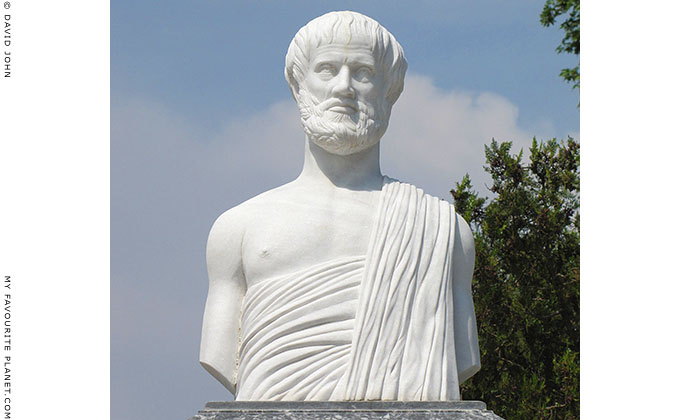
A modern statue of Aristotle of Stageira on Olympiada's main square. |
| |
The Greek philosopher and polymath Aristotle (Ἀριστοτέλης, Aristoteles, "the best purpose"; 384-322 BC) is Stageira's most famous native. He was a student of Plato and established his own schools, including the Lyceum in Athens and at Mieza (today Naoussa, Macedonia), where he taught three future kings, Alexander the Great, Ptolemy and Cassander. He wrote on a wide range of subjects, including logic, physics, metaphysics, poetry, theatre, music, rhetoric, linguistics, politics, ethics, biology and zoology.
Along with Socrates and Plato, he is one of the most famous ancient Greek philosophers whose works still have an influence on thinking today. The single name Aristotle is known all over the world, though he is also referred to as "Aristotle of Stageira" or "Aristotle the Stageirite".
His father Nicomachos (Νικόμαχος) was a doctor and personal physician of King Amyntas III of Macedonia (Ἀμύντας Γ΄, ruled 393-370 BC), the father of Philip II and grandfather of Alexander.
In his works Aristotle wrote little about his own life, but his fame ensured that other ancient writers were to publish biographies of the philosopher. The earlier bios have not survived, however in the 1st century BC Greek historian Dionysius of Halicarnassus summarized them in his literary letter to Ammaeus:
"Aristotle was the son of Nicomachus, who traced his lineage and his profession back to Machaon, the son of Asclepius [i.e. follower of Asklepios; medical doctor]. His mother, Phaestis, was descended from one of those who led the expedition from one of those who led the colony to Stageira from Chalcis [1].
He was born in the ninety-ninth Olympiad, when Diotrephes was archon at Athens, and was, therefore, three years older than Demosthenes.
In the archonship of Polyzelus, after the death of his father, he went to Athens, being then eighteen years of age. Having been introduced to the society of Plato, he spent a period of twenty years with him.
When Plato died, in the archonship of Theophilus, he went to the court of Hermias, the tyrant of Atarneus, and spent three years with him before retiring to Mytilene in the archonship of Eubulus.
Thence he proceeded, during the archonship of Pythodotus, to the court of Philip, and spent eight years there as Alexander's tutor.
After the death of Philip, in the archonship of Evaenetus, he returned to Athens, and taught in the Lyceum for a period of twelve years.
In the thirteenth year, after the death of Alexander in the archon-year of Cephisodorus, he set off for Chalcis, where he fell ill and died at the age of sixty-three.
Such, then, are the records transmitted to us by the biographers of Aristotle."
Dionysius of Halicarnassus, The First Letter to Ammaeus [2]
|
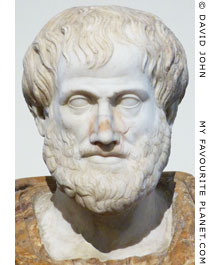
Marble bust of Aristotle.
Roman copy after a Greek
bronze original by Lysippos,
commissioned by Alexander
the Great circa 330 BC.
Palazzo Altemps,
National Museum of Rome.
Inv. No. 8575. |
| |
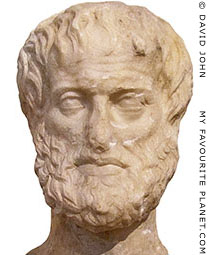
Head of Aristotle from a double-
headed herm, found in Athens.
Roman period copy, probably
also after Lysippos.
National Archaeological Museum,
Athens. Inv. No. 3772. |
| |
See also Digging Aristotle,
the Cheshire Cat Blog about
Aristotle's Lyceum in Athens. |
| |
| |
Nicomachos' friendship with Amyntas and his relations with the royal court at Pella must have helped Aristotle with his career, and Philip was to remember him when he was choosing a tutor for his son. Since Aristotle was only two years older than Philip they may have known each other from childhood.
Here is what the Greek historian Plutarch had to say about the relationship beween Alexander and Aristotle:
"And since Philip saw that his son's nature was unyielding and that he resisted compulsion, but was easily led by reasoning into the path of duty, he himself tried to persuade rather than to command him; and because he would not wholly entrust the direction and training of the boy to the ordinary teachers of poetry and the formal studies, feeling that it was a matter of too great importance, and, in the words of Sophocles,
'A task for many bits and rudder-sweeps as well,'
he sent for the most famous and learned of philosophers, Aristotle, and paid him a noble and appropriate tuition-fee. The city of Stageira, that is, of which Aristotle was a native, and which he had himself destroyed, he peopled again, and restored to it those of its citizens who were in exile or slavery.
Well, then, as a place where master and pupil could labour and study, he assigned them the precinct of the nymphs near Mieza, where to this day the visitor is shown the stone seats and shady walks of Aristotle.
It would appear, moreover, that Alexander not only received from his master his ethical and political doctrines, but also participated in those secret and more profound teachings which philosophers designate by the special terms "acroamatic" and "epoptic", and do not impart to many. For after he had already crossed into Asia, and when he learned that certain treatises on these recondite matters had been published in books by Aristotle, he wrote him a letter on behalf of philosophy, and put it in plain language. And this is a copy of the letter:
'Alexander, to Aristotle, greeting. Thou hast not done well to publish thy acroamatic doctrines; for in what shall I surpass other men if those doctrines wherein I have been trained are to be all men's common property? But I had rather excel in my acquaintance with the best things than in my power. Farewell.'
Accordingly, in defending himself, Aristotle encourages this ambition of Alexander by saying that the doctrines of which he spoke were both published and not published; for in truth his treatise on metaphysics is of no use for those who would either teach or learn the science, but is written as a memorandum for those already trained therein.
Moreover, in my opinion Alexander's love of the art of healing was inculcated in him by Aristotle preeminently. For he was not only fond of the theory of medicine, but actually came to the aid of his friends when they were sick, and prescribed for them certain treatments and regimens, as one can gather from his letters.
He was also by nature a lover of learning and a lover of reading. And since he thought and called the Iliad a viaticum of the military art, he took with him Aristotle's recension of the poem, called the Iliad of the Casket, and always kept it lying with his dagger under his pillow, as Onesicritus informs us; and when he could find no other books in the interior of Asia, he ordered Harpalus to send him some. So Harpalus sent him the books of Philistus, a great many of the tragedies of Euripides, Sophocles, and Aeschylus, and the dithyrambic poems of Telestes and Philoxenus.
Aristotle he admired at the first, and loved him, as he himself used to say, more than he did his father, for that the one had given him life, but the other had taught him a noble life; later, however, he held him in more or less of suspicion, not to the extent of doing him any harm, but his kindly attentions lacked their former ardour and affection towards him, and this was proof of estrangement.
However, that eager yearning for philosophy which was imbedded in his nature and which ever grew with his growth, did not subside from his soul, as is testified by the honour in which he held Anaxarchus, by his gift of fifty talents to Xenocrates, and by the attentions which he so lavishly bestowed upon Dandamis and Calanus."
Plutarch, Alexander [4]
According to legend, after Aristotle's death, the Stageirites brought his remains from Chalcis to Stageira for burial, and an altar was built over his grave at a place in the city known as "the Aristoteleion", a heroon (place of hero worship) where he was honoured by an annual festival called the "Aristoteleia". This festival has recently been revived by the inhabitants of Olympiada.
The Greek architect Dr. Konstantinos L. Sismanidis (Κωνσταντίνος Λ. Σισμανίδης, also referred to as Kostas), who directed excavations at Stageira 1990-2000, believes that the remains of a structure discovered near one of the ancient city gates is the grave of Aristotle. [5] His announcement of this theory in May 2016 was reported in the media around the world. Unfortunately, Dr. Sismanidis has so far been unable to provide sufficient evidence to convince scholars. |
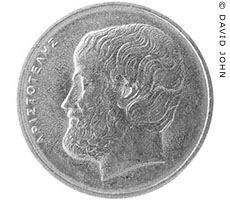
1986 Greek 5 Drachma coin
with a portrait of Aristotle. [3]
Engraved by Th. Papagiannis. |
| |
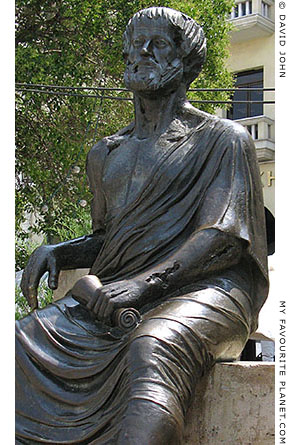
A modern bronze statue of Aristotle,
made by G. Georgiades in 1990.
Aristotle Square (Πλατεία Αριστοτέλους,
Plateia Aristotelous), Thessaloniki. |
| |
| |
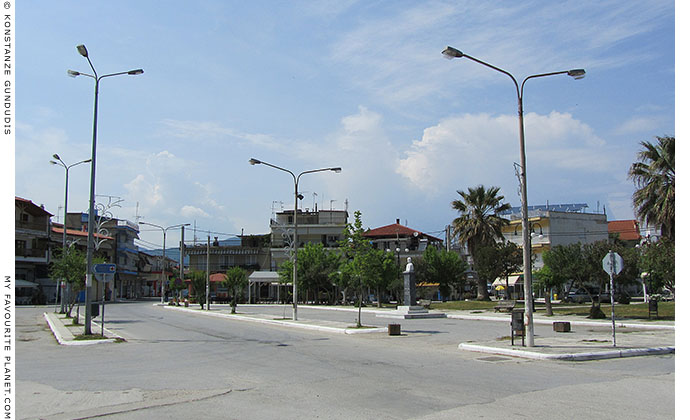
The main square of Olympiada village (see Olympiada gallery page 4).
This is also where buses from Thessaloniki terminate
(see How to get to Stageira and Olympiada).
On the right is the statue of Aristotle and a small park.
photo: © Konstanze Gundudis |
| |
| |
Notes, references and links |
 |
|
1. Phaestis, Aristotle's mother
According to the Roman writer Pliny the Elder (23-79 AD), the painter Protogenes (Πρωτογένης) painted a portrait of Phaestis (or Phaestias; Greek, Φαιστιάδα, Phaestiada), and it was Aristotle himself who "advised him to paint the exploits of Alexander the Great, as being certain to be held in everlasting remembrance... His last works were representations of Alexander and the god Pan."
Pliny the Elder, Natural History, Book 35, chapter 36. At Perseus Digital Library.
2. Dionysius of Halicarnassus on Aristotle
Dionysius of Halicarnassus (Greek, Διονύσιος Ἀλεξάνδρου Ἁλικαρνᾱσσεύς, Dionysios son of Alexandros of Halikarnassos, circa 60 BC – after 7 BC), Greek historian and teacher of rhetoric during the reign of Emperor Augustus.
His literary letter, the First Letter to Ammaeus, in which he refutes claims that the Athenian orator Demosthenes was influenced by Aristotle's writings on rhetoric, contains one of the oldest surviving biographies of Aristotle.
Dionysius of Halicarnassus, The three literary letters, Ep. ad Ammaeum I, Ep. ad Pompeium, Ep. ad Ammaeum 2. First Letter to Ammaeus (I Epistula ad Ammaeum), V-VI, pages 61-63. In Greek and English, edited and translated by William Rhys Roberts (1858-1929).
Cambridge University Press, 1901. At the Internet Archive. |
|
|
3. Aristotle five drachma coin
The copper-nickel (Cu+Ni) coin bearing the profile of Aristotle, engraved by Th. Papagiannis, was in circulation in Greece from 1982 until the introduction of the Euro on 1 January 2002. 16,730,000 coins of the 1986 issue were minted. (Photo from the collection of the author.)
Here are a few factoids for coin enthusiasts.
Composition: Copper 75 %, Nickel 25 %
Diameter: 22.5 mm
Thickness: 1.85 mm
Weight: 5.5 grams
4. Plutarch on Alexander the Great and Aristotle.
Plutarch (Greek: Πλούταρχος; name as Roman citizen Lucius Mestrius Plutarchus, Μέστριος Πλούταρχος, circa 46-120 AD), Greek historian, biographer and essayist, born in Chaeronea, Boeotia.
Parallel Lives, his best known work, is a collection of biographical essays, arranged in pairs comparing the life and career of a famous Greek with that of a prominent Roman. He paired Alexander with Julius Caesar.
Plutarch, The Parallel Lives; The Life of Alexander, (Part 1 of 7), chapters 7-8. Translated by Bernadotte Perrin. Loeb Classical Library, Harvard University Press, 1919.
At Bill Thayer's LacusCurtius: Into the Roman World website, University of Chicago. |
|
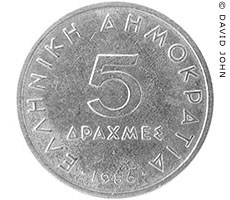
Reverse side of the 1986
Greek 5 Drachma coin. |
|
5. Sismanidis on Aristotle's grave
Sismanidis' announcement was made on Thursday May 26 2016, during his address Ο τάφος του Αριστοτέλη στα Αρχαία Στάγειρα (Aristotle's grave at Ancient Stageira), during the World Congress "Aristotle 2400 Years", at the Aristotle University of Thessaloniki, 23-28 May 2016.
See:
Programme of the World Congress "Aristotle 2400 Years".
At aristotleworldcongress2016.web.auth.gr.
Kostas L. Sismanidis, Ο τάφος του Αριστοτέλη στα αρχαία Στάγειρα. Η ανασκαφική αποκάλυψη (Aristotle's grave at Ancient Stageira: an excavational revelation). Μέθεξις (Metheksis), Thessaloniki, 2016. www.metheksis.gr. Paperback, 104 pages. ISBN 978-618-5226-11-4.
The accounts of Aristotle's grave were recorded in Medieval manuscripts in Arabic and Syriac, known as Vitae Aristotelis, thought to be based on a Greek biography of Aristotle by Ptolemy al-Gharib (known only by his name in Arabic, Ptolemy the foreigner), an Arabic translation of which was discovered in the 1970s in Istanbul.
The tradition was also related in the 14th century travel memoir, The travels of Sir John Mandeville, which first circulated around 1357-1371, and the earliest surviving version of which is in French.
"In this country was Aristotle born, in a city called Stagyra, a little from the city of Thrace. And at Stagyra Aristotle lieth; and there is an altar upon his tomb. And they make great feasts for him every year, as though he were a saint. And at his altar they hold their great councils and their assemblies, expecting that through inspiration of God and of him they shall have the better council."
The voyages and travels of Sir John Mandeville, knight, Chapter III, "Of the City of Constantinople, and of the Faith of Greeks", pages 16-17. Cassell and Company Limited, 1909. At the Internet Archive. |
|
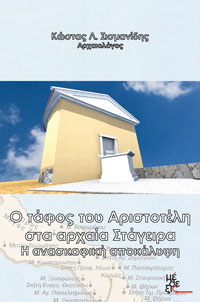
The cover of Sismanidis' book
Ο τάφος του Αριστοτέλη στα
αρχαία Στάγειρα. Η ανασκαφική
αποκάλυψη (Aristotle's grave at
Ancient Stageira: an excavational
revelation). |
|
Photos, maps and articles: copyright © David John,
except where otherwise specified.
Additional photos: copyright © Konstanze Gundudis
All photos and articles are copyright protected.
Images and materials by other authors
have been attributed where applicable.
Please do not use these photos or articles without permission.
If you are interested in using any of the photos for your website,
project or publication, please get in contact.
Higher resolution versions are available on request.
My Favourite Planet makes great efforts to provide
comprehensive and accurate information across this
website. However, we can take no responsibility for
inaccuracies or changes made by providers of services
mentioned on these pages. |
| |
 |
Visit the My Favourite Planet Group on Facebook.
Join the group, write a message or comment,
post photos and videos, start a discussion... |
|
|
| |
|
|
| |
| |
 |
| |
 |
| |
 |
| |
 |
| |
George Alvanos
rooms in
Kavala's historic Panagia District
Anthemiou 35,
Kavala, Greece
kavalarooms.gr
|
| |
 |
| |
 |
| |
Olive Garden Restaurant
Kastellorizo,
Greece
+30 22460 49 109
kastellorizo.de
|
| |
Papoutsis
Travel Agency
Kastellorizo,
Greece
+30 22460 49 286
greeklodgings.gr
|
| |
|